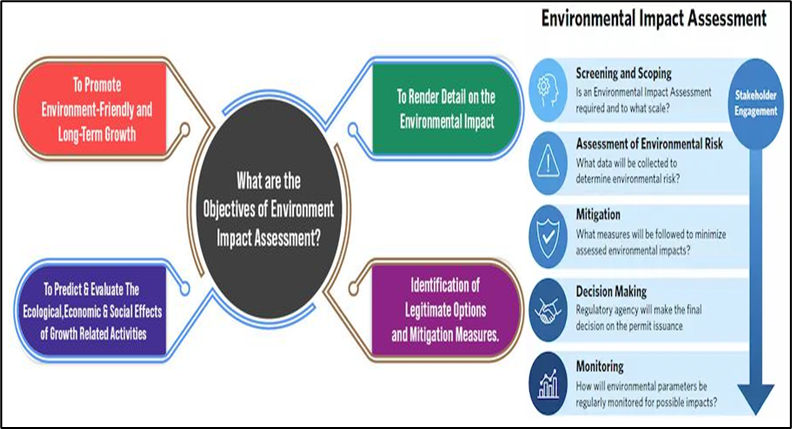Why in News?
- The Supreme Court has urged legislators and policy experts to ensure that Environment Impact Assessment (EIA) studies are done before giving the green signal for urban development projects in India’s cities.
What’s in Today’s Article?
- What is EIA?
- What are the Stages of EIA?
- What are the Rules that Govern the EIA Process?
- What are the Concerns Related to the EIA?
- News Summary with respect to EIA for Urban Development Projects
What is EIA?
- The UN Environment Programme (UNEP) defines EIA to be an analytical process that systematically examines the possible environmental consequences of the implementation of a given activity (project).
- It is aimed to ensure that the environmental implications of decisions related to a given activity are taken into account before the decisions are made.
- In India, there are 39 categories of projects that require an environmental clearance (EC) process and are subject to EIA.
- The EIA notification was first formulated in India in 1994, under the Environment (Protection) Act 1986.
- The Act made environmental clearance mandatory for expansion, modernisation of existing projects, and for the establishment of new projects.
What are the Stages of EIA?
- The environmental clearance process comprises four stages, namely, Screening; Scoping; Public Consultation and Appraisal.
- The Expert Appraisal Committee (EAC) is a multi-disciplinary sectoral appraisal committee, whose primary role is to give recommendations to the MoEFCC on project proposals after considering the potential impacts of the project.
- Based on these recommendations, the MoEFCC either rejects the proposal or grants a clearance with conditions which would mitigate the impacts or compensate for the same.

What are the Rules that Govern the EIA Process?
- To decentralize the process of project clearance, the EIA Notification 2006 has categorized the projects into Category ‘A’ and Category ‘B’ based on their impact potential.
- Category ‘A’ projects will be appraised at the Central level while Category ‘B’ projects at the State level.
- Category A projects require mandatory environmental clearance and thus they do not have to undergo the screening process.
- Category B projects undergo a screening process and are further classified into B1 (Mandatorily requiring EIA) and B2 (Not requiring EIA).
- Draft EIA Notification 2020:
- The new draft aims to increase transparency and streamline compliance by incorporating multiple notifications, amendments, circulars, court and tribunal directions, and so on.
What are the Concerns Related to the EIA?
- Exemptions doing away with the need for green clearance:
- For example, the MoEFCC recently amended EIA rules to exempt the controversial Char Dham project from EC.
- The project includes widening 899 km of roads in ecologically sensitive areas of Uttarakhand to improve connectivity to Kedarnath, Badrinath, Yamunotri, and Gangotri shrines.
- The case is presently being heard in SC, which has set up a high-powered committee to look into the matter.
- A time-consuming process: The EIA process, which is sometimes excessively focused on scientific investigation, takes time and causes project delays.
- There has been little public participation in the actual implementation process and the compliance monitoring following EIA is rare.
- Biodiversity is usually ignored. There is a rising awareness of the importance of including biodiversity issues in EIA.
News Summary with respect to EIA for Urban Development Projects:
- Background in which the recent judgement came:
- In a judgment, the SC referred to media reports of how haphazard urban development has ruined the ‘Garden City’ of Bengaluru as witnessed during a major spell of rain in 2022.
- The city struggled for drinking water while it lay submerged after the downpour.
- The recent judgment came in regard to a proposal to convert independent residential units into apartments in Chandigarh Phase 1.
- The court prohibited the move in order to protect the heritage status of ‘Corbusian’ Chandigarh (Chandigarh was planned by the famous French architect Le Corbusier).
- What are the SC’s observations?
- The judgment referred to a publication by the UNEP, which underscored that more than half of the world’s population is now living in urban areas.
- It is high time that the legislature, the executive and policymakers at the Centre as well as at the State make necessary provisions for carrying out EIA studies before permitting urban development.
- It is necessary that a proper balance is struck between sustainable development and environmental protection.
- Way Ahead Suggested by the UNEP:
- The City Development Strategies (CDSs) have shown how to integrate environmental concerns in long-term city visioning exercises.










